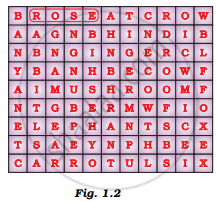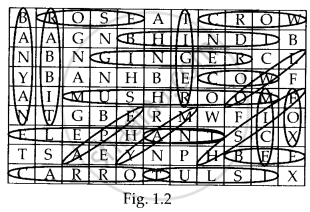Advertisements
Advertisements
Question
Spot as many organisms as possible in the puzzle given in Figure 1.2 by encircling them as shown. Write the names on a sheet of paper and categorise them into autotrophs and heterotrophs. Classify the heterotrophs into herbivores, carnivores, omnivores and saprophytes.

Solution

Autotrophs: rose, mango, bhindi, carrot, banyan, tulsi, ginger, yam
Heterotrophs: elephant, ant, yeast, tiger, mushroom, fox, mice, owl, cow, cow, rabbit, beef, fish, ape
Herbivores: elephant, cow, rabbit, bee
Carnivores: tiger
Omnivores: ant, mice, owl, crow, fox, ape
Saprophytes: mushroom, yeast
Note: Fish can be herbivores, carnivores or omnivores depending on the species.
APPEARS IN
RELATED QUESTIONS
All the animals can be divided into three groups on the basis of their eating habits. Name the three groups.
How does Amoeba engulf the food particle?
What is common for Cuscuta, ticks and leeches?
Name the five steps which occur in the process of nutrition in animals.
The correct order of steps occurring in nutrition in animals is:
(a) Ingestion → Absorption → Digestion → Assimilation → Egestion
(b) Ingestion → Digestion → Assimilation → Absorption → Egestion
(c) Ingestion → Digestion → Absorption → Assimilation → Egestion
(d) Ingestion → Assimilation → Digestion → Absorption → Egestion
A unicellular animal P having no fixed shape ingests a food particle by forming temporary finger-like projections Q. The food particle is engulfed with a little surrounding water to form a temporary stomach R inside it. The chemicals S from surrounding cytoplasm enter into R and break down food into small and soluble molecules by chemical reactions. The digested food is absorbed directly into cytoplasm by the process T. The undigested food is thrown out of the body by the rupture of a cell organelle U in a process called V.
(a) Name the unicellular animal P.
(b) What are (i) Q, and (ii) R?
(c) Name (i) chemical S, and (ii) process T.
(d) Name (i) organelle U, and (ii) process V.
What type of arrangement exists in the bodies of large animals to meet their oxygen requirements adequately?
In which mode of nutrition an organism derives its food from the body of another living organism without killing it?
The mode of nutrition found in fungi is:
Generally, food is broken and absorbed within the body of organisms. In which of the following organisms is it done outside the body?
